Table of contents
- Comparison test Aprilia RSV 1000 R Factory, Bimota DB7, Ducati 1098 S Italian premium bikes
- Italian noble bikes
- Rhythm and tact
- Grande trio
- Comfort and luxury
- Conclusion, data and evaluation
- Aprilia: sporty future with V4
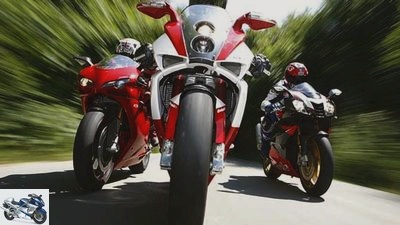
K
motorcycles
Comparison test Aprilia RSV 1000 R Factory, Bimota DB7, Ducati 1098 S
Comparison test Aprilia RSV 1000 R Factory, Bimota DB7, Ducati 1098 S
Italian premium bikes
Content of
Bimota’s new wonder weapon DB7 beguiles not only with a fascinating exterior but also with a powerful engine, taken from Ducati’s super sports car 1098S. Reason enough for PS to exclusively compare the two two-cylinder units and find out how much Aprilia’s noble bike RSV 1000 R Factory has to offer.
Sebastian Lang
09/17/2008
Italian noble bikes
It’s a bit like showing up with Heidi Klum in front of the local ice cream parlor. Clusters of men gather, camera phones are pulled out, a mixture of envy and desire sparkles in the eyes of the beholder. Responsible for this surreal scene, however, is a beauty of a completely different caliber. Bimota DB7. Bimota. The name awakens dusty emotions and memories in long-established Italo enthusiasts, and lets times long bygone come to life. The new one would not need this past bonus at all? its beautiful details speak for themselves: the fork with milled feet and radially screwed Brembo monoblocks. The composite frame made of oval red tubular space and also perfectly milled light metal. The suspension strut, which can be height-adjusted by 20 mm using an eccentric, and the rocker arm, which is also made of red tubular space. Even the design of the side stand is appealing. Anyone who does not get wet eyes or weak knees at the sight of this beauty is either blind or simply has no sense of aesthetics. Which is not bad, because the young Riminese has a lot to offer on the engine side as well. Her from Ducati’s Superstar and two-cylinder reference 1098 The removed Testastretta Evoluzione exudes as much charm as the chic exterior and boasts plenty of performance ?? The manufacturer specifies 154 hp.
A superbike from Bimota with a chic exterior and a competitive two-cylinder? Sounds almost too good to be true. PS wanted to know what is behind the promising package and presented the young Wilde exclusively to two Italian noble sisters: Ducati 1098S and Aprilia RSV 1000 R Factory. At the first casting it is noticeable: Compared to the large, round Aprilia, it works DB7 small and slim like Kylie Minogue next to Brigitte Nielsen. The age difference between the conceptually ten year old Mille and the dewy Bimota is obvious. Even Italy’s flagship model Ducati 1098S, despite its slim silhouette and sporty proportions, has a hard time keeping up with the Riminese woman and throws the new one with a bright red head poisonous looks: ?? Well, wait, I’ll get you … ?? Time to let the action speak. The turn of the ignition key brings the widescreen information center of the Ducati to life, the push of the start button brings rhythmic movement in the cylinder, motorcycle and driver and ends in a sonorous two-cylinder bollern. No production four-cylinder in the world celebrates the starting process so impressively.
Rhythm and tact
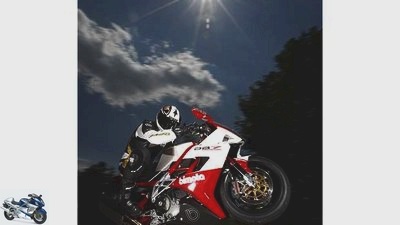
K
The Bimota DB7 can be described as a dream combination of great details and an ingenious engine.
The DB7 composes the overture of its Italian two-cylinder opera in a similarly dramatic manner. The two pistons beat the rhythm with a full, aggressive tone, and the unmistakable rattle of the dry clutch chases pleasant shivers down your spine. You could just sit next to the for hours Bimota stand, lose yourself in its details and let yourself be carried away by its sound into another world. But the curiosity is stronger. Why can’t you hear the dry clutch of the Bimota and the Ducati? A look at the clutch cover reveals the answer. While the 1098 almost ashamedly hides sound and optics behind a bland gray record, the Bimota is much more revealing, only covers half of its clutch with a light carbon cap and thus leaves room for stealthy male glances at its inner values. When it comes to the exhaust sound, the DB7 goes less subtle. Instead of an underseat double pipe, it discharges the exhaust gases from the 1099 cm³ two-cylinder? Incidentally, the first Ducati Superbike engine in a Bimota since the Tesi 1d 1991 ?? via a mighty, laterally mounted titanium muffler. The Riminese reprogrammed the injection to match the modified exhaust system, which explains the power deficit of nominally 8 hp compared to the 162 hp 1098.
Nevertheless, the Ducati DB7 shows its pretty rear on the country road, because apart from a significant drop in torque between 2500 rpm and 3000 rpm, the DB7 sprints forward like Anni Friesinger at her best times and hangs the fast red from Bologna between 4000 rpm and 6500 rpm significantly. A dream, how the V2 engine starts already at moderate speeds, roars, seething and vibrates under the driver’s rear and transforms the trees on the roadside into a green-blurred watercolor. Pure goosebumps. The Ducati 1098S doesn’t make things much worse overall, pushes more than 90 Nm at 4000 rpm, but then also falls into a torque hole and loses contact with the Bimota a little. Only at 7700 rpm does she manage to put the young Riminese woman in her place with a whopping 123 Nm.
It’s nice that both 1099 cubic 90 degree V2 engines run very well despite all the power and that the load change reactions are typically low for Ducati. The grayed Aprilia engine cannot keep up with this idea. The 101 cm³ smaller 60-degree V2 feels weaker over the entire speed range. In addition, the Mille engine treats itself to a small attack of weakness at 2500 rpm, from which, unlike the young and vital DB7, it only recovers at 3500 rpm. In everyday life this means: If the tachometer needle is below 4, you don’t even need to start to overtake. Instead, it is advisable to ask the somewhat bony gearbox for a lower gear step in order to iron over second-rate country lanes with sonorous humming and good vibrations.
Grande trio
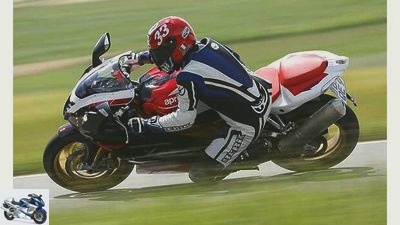
K
The factory chassis is a dream, the engine is no longer up-to-date.
Because this is exactly where Aprilia’s finest hour strikes. Since its introduction in 2003, the Factory’s Ohlins chassis has been one of the best that can be driven on country roads. Sensitively and neatly balanced, the fork and shock absorber of the Mille filter away all bumps, respond cleanly and don’t let nasty asphalt corners bother you. In connection with the great feedback, it can be decelerated deep into tight corners on the moderately sporty brake and cut through the apex in a tight line. Not bad for one ??? Forgiveness! ?? old lady. The two young stars could learn a lot from that. Because both Bimota and Ducati suffer from a very tight hindquarters and a relatively soft front. While the 1098S steadfastly stays on track when pulling on the brake lever, despite the fork plunging deeply, the DB7 gets nervous during hard braking maneuvers and wobbles its buttocks uncertainly. Braking stability looks different. In order not to strain the pilot’s nerves with an overbite brake, the Riminese now only use two pads per pair of pliers instead of the individual pads that were installed at the presentation in the Brembo monoblocs of their super sports car ?? just like Ducati. The result is a great sports brake, perfectly adjustable, with a full bite and a clean pressure point.
Unfortunately, the joy is short-lived, because another problem for the pretty athlete reveals itself at the entrance to the curve: the steering damper is still too tight even when it is completely open and forces the pilot to pull unnecessarily hard on the handlebars at the turn-in point. It’s a shame, because the Bimota follows the desired line with agility and much more maneuverability than the two competitors in alternating curves and in radii that require only little steering input, and the 195.5-kilo lightweight can be easily slammed into corners with ease and with one Accelerate mountain of torque out of the curve. Country road fun at its best. Fortunately, the steering damper can be removed. The Ducati can live well with the defeat in the handling classification. In any case, your main focus is not on folding down like a bike, but on cornering stability. Full and sensitive, it scurries through wide arcs at a great incline, reliably informs the pilot about the current state of grip of the Pirelli Supercorsa Pro and thunders happily towards the next straight. That the undercarriage of the Reds still doesn’t quite match the Ohlins components of the Aprilia the 1098S makes up for it with its seating position. Its wonderfully narrow tank, the soft seat padding and the moderate knee angle allow the pilot to get off the motorcycle almost painlessly, even after long weekend tours, which is atypical of a super athlete. Only the wrists are a reminder that this motorcycle was built for slipstream duels on the racetrack.
Comfort and luxury
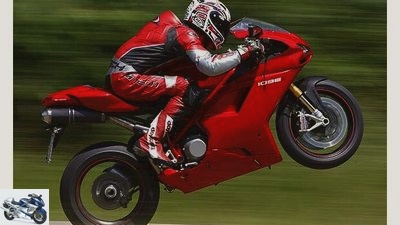
K
Wheelies with the Duc? Very simple: 2nd gear, accelerate, done.
The DB7, on the other hand, permanently reminds its pilot of its actual destination. The wide handlebars stretch the pilot far over the tank, the seat roll feels as if it has been parched for a week in the bakery’s shop, and the knee angle is a little narrower than on the 1098. Overall, it feels like it Bimota less comfortable, but much more sporty than the reference from Bologna. Consequently, the rear-view mirrors only provide a reasonably reasonable view to the rear in a racing position and under the arms. But it pleases with a very narrow silhouette and a wonderfully tight knee. The Aprilia cannot serve that. The wide tank forces the pilot’s thighs wide apart, and the knee angle takes getting used to. The footrests are placed far in front and very high, leaving few opportunities to support yourself when accelerating and are simply uncomfortable in the long run. The seat upholstery is completely different: especially in direct comparison to the quasi-unpadded Bimota, the Aprilia looks like a sofa, softly embeds the driver’s rear and arouses associations with tourism rather than super sports. The seat cushion is significantly higher than that of the Ducati and Bimota. The handlebars, which are subjectively low compared to the high seating position, are positioned very close to the driver and, in conjunction with the high notches, force the pilot into a very concentrated seating position.
Ten years without a thorough further development are obviously also due to the ergonomics of the Aprilia RSV 1000 R not passed by without a trace. However, the old age of the Aprilia concept has one big advantage: the price. At 15,799 euros, it is a Triumph Daytona 675 cheaper than the noble light one from Rimini. Luxury for the small budget, so to speak. The 1098S, relatively new on the market and both technically and optically state-of-the-art, does not need such a discontinued model tactic: If you don’t have the 21,295 euros for the S, you have to fall back on the standard version, whoever has more want to invest, an R can afford. The Bimota also knows what it’s worth: 26,656 euros. A treat for a select group of customers. The sales figures of the super sports car are calculated accordingly. Bimota would like to sell 35 units in Germany. Given their qualities, that shouldn’t be too difficult. Maybe it would be a bit cheaper without a steering damper? the handling would do it good. If the money is still not enough to be sure of concentrated attention the next time you visit the ice cream parlor, you can always ask Heidi Klum if she wants to come with you.
Conclusion, data and evaluation
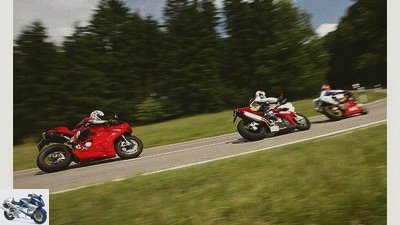
K
Country road dreams: Out and about with three beautiful Italian women. What more do you want? But what about the inner values and talents?
Just missed that Bimota DB7 the test victory. With beautiful details, typical Italo sound and a well-tuned engine, it beguiles the eyes, ears and hearts of the pilot. The steering damper that is too tight costs the decisive star. This is how the Ducati wins: Without weaknesses and with a lot of potential, it is at the front everywhere. The Aprilia shines with a great chassis, but weakens the engine and seating position.
Aprilia: sporty future with V4
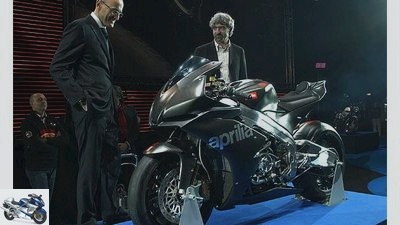
Aprilia
This is roughly what Aprilia’s new racetrack rocket with a V4 engine will look like.
It’s no longer a secret: Aprilia will be launching the RSV4 super sports car next year and will, like the Japanese, rely on four cylinders in the supreme discipline in the future. In order to differentiate itself from the competition from the Far East, the Italians did not develop an inline four-cylinder, but a V4 with a 65-degree cylinder angle, which costs more to produce but is more compact. The new one will be on the market in spring 2009, initially as a race-oriented factory, probably only in small numbers. Aprilia has to build 250 homologated RSV4s by the end of January in order to be able to start with the four-cylinder in the Superbike World Championship. But homologation or not: “The factory”, explains Aprilia boss Leo Mercanti, “is based on the racing version and is intended for use on the racetrack.” Mercanti does not want to say how much horsepower the Factory will have, just this much: “At least no less than the competition.” In other words: it should be at least 180 hp. The envisaged price is less than 20,000 euros. A slightly tamer and, according to Mercanti, around ten percent cheaper R version of the four-cylinder will follow in autumn 2009.
Visually, the RSV4 is based heavily on the superbike, of which Aprilia has already put the first photos into circulation. Both series versions of the RSV4 come with an aluminum frame and are equipped with Aprilia’s ride-by-wire system. In addition, the two-cylinder RSV 1000 will remain in the range for the time being. No major innovations are to be expected for him, at most one or the other optical update. Since the drive is built by Rotax, i.e. it is a third-party engine, Aprilia no longer invests in its further development, but prefers to take care of the in-house two-cylinder, which drives the Shiver and the Dorsoduro and is to be expanded to 1200 cm³. This V2 thus serves the mid-range segment of the brand; The sporty RSV 1000 should expire in the medium term.
On the other hand, Aprilia has high hopes for the new V4, because with it one wants to finally start again after the lean times that followed the near bankruptcy in 2004. Whether or not these hopes will come true depends heavily on Aprilia’s success in the Superbike World Championship. The racing motorcycle called RSV4 Race Machine will be officially presented on September 10th at the company headquarters in Noale. It has not yet been decided who will be in the saddle, but Aprilia negotiated with Max Biaggi at the Superbike World Championship race in Brno in mid-July. He started his career at Aprilia and is still good for fast times. Aprilia is looking for a strong driver, because the Race Machine has not taught anyone to fear during the test drives? report pilots who shared the route with test driver Alex Hofmann. The Aprilians still have a winter to train their race machine winning qualities.
Related articles
-
Superbike World Championship: technology of the Aprilia and Ducati factory machines
motorcycles Superbike World Championship: Technology of the Aprilia and Ducati factory machines Superbike World Championship: Technology of the Aprilia…
-
Comparison test Ducati Monster 1200 S, Honda Fireblade, Kawasaki Z 1000 SX, Suzuki GSX-S 1000 F
jkuenstle.de 27 pictures jkuenstle.de 1/27 The disguised Suzuki GSX-S 1000 F has to prove itself in the field of competitors. jkuenstle.de 2/27 Nice is…
-
Driving report Aprilia RSV4 Factory
Aprilia 24 pictures Aprilia 1/24 in the superbike variant Aprilia 2/24 Aprilia RSV4 superbike. Aprilia 3/24 Aprilia RSV4 superbike. Aprilia 4/24 Aprilia…
-
Jahn 31 pictures Photos: fact / Jahn 1/31 Honda Fireblade, Kawasaki Ninja ZX-10R, Suzuki GSX-R 1000, Yamaha YZF-R1, Ducati 1198S, KTM 1190 RC8 R and…
-
jkuenstle.de 65 pictures jkuenstle.de 1/65 All candidates in the crossover comparison test are around 1000 cm³, this time they are represented ……
-
Comparison test Yamaha FZS 1000 Fazer-R1 and Honda Hornet S-CBR 600 F
Jahn motorcycles Super athlete Comparison test Yamaha FZS 1000 Fazer / R1 and Honda Hornet S / CBR 600 F Comparison test Yamaha FZS 1000 Fazer / R1 and…
-
Comparison test Honda CBF 1000 and Honda CBF 1000 F
Jahn 10 pictures Rudolph 1/10 Even when the going is steep uphill, the CBF 1000 F pulls on without ceasing. Rudolph 2/10 Now adjustable: the spring…
-
Comparison test: Ducati 998S against 1098S
motorcycles Comparison test: Ducati 998S against 1098S Comparison test: Ducati 998S against 1098S power & Glory Content of After the unloved 999, the…
-
Comparison test: basic superbikes from Ducati and Aprilia
fact 43 pictures fact 1/43 Two Italian superbikes in comparison: fact 2/43 The basic version of the Ducati 1199 Panigale … fact 3/43 … competes…
-
Comparison test between Suzuki DL 1000 V-Strom and Yamaha TDM 900
Artist motorcycles Comparison test between Suzuki DL 1000 V-Strom and Yamaha TDM 900 Comparison test between Suzuki DL 1000 V-Strom and Yamaha TDM 900…